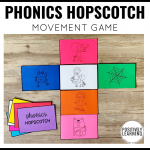
I feel like the topic of wiggly students is something that's not addressed nearly enough. Or maybe it's addressed in conversations sprinkled with developmentally appropriate research (“children need to move!”) and theory (“kinesthetic learners learn when their bodies are in movement”).

Table of Contents
ToggleI know it can't be just me.
Or maybe it is. Either way, I've definitely had classes where the entire group feels the need to move and the two minute brain break during a fifty minute class wasn't nearly enough.

As a teacher, I often took it too personally when a student was not making progress. I know that isn't necessarily helpful, but if you're a teacher reading this, I'm sure you know how it feels.
The first place I look for solutions is my content presentation and pacing. These questions helped me reflect on what was working and what clearly wasn't:

This is more of a preventative measure than solution, but it's important. Remember that I mentioned those two minute brain breaks? They actually are VERY helpful, but in my own teaching, I found I waited too long to use them. I was waiting until the symptoms of the “wiggles” started before utilizing them.
I highly suggest incorporating those quick breaks BEFORE the wiggles began. I know it's REALLY hard to interrupt the lesson flow, but a well-placed brain break can help the lesson be much more effective than waiting until everyone's feeling restless.
It's helpful to remember that a brain break is intentional and serving an important purpose in student development (vs. viewing it as a “reward”).

Now this last solution is one I came up out of sheer desperation when the first two solutions weren't quite enough.
I learned about this solution with my reading intervention group that met twice a day – once before lunch (Guided Reading format) and then again after recess (phonics intervention). I used to say silent prayers for outdoor recess so they could expel some of their extra energy. #sorrynotsorry
Finally I decided to join them! Why push back on all that energy? I mean, it wasn't exactly working, so I started to look for opportunities to teach the content using movement.
Once we started seeing results in both engagement, learning, and attitude (for all of us), I was HOOKED!
What kind of activities did we do? There are so many creative ways to combine learning and movement… musical chairs, Around the World, Red Light Green Light, and one of our favorites:
I did learn quickly that there still needed to be some structure in place during these movement games as we were still learning about impulse control.
Overall, adding movement was successful and my students also gained valuable social interaction and experience with following directions.

I hope you find these solutions helpful for your own wiggly students! Check out more classroom movement ideas here:


I’m Jennifer and I was a special educator in the elementary school setting over the past decade. I entered the classroom every day dedicated to making learning inclusive AND engaging.





This website uses cookies to ensure you get the best experience on our website. See full disclosure here.
This website uses cookies to ensure you get the best experience on our website.
See full disclosure here.